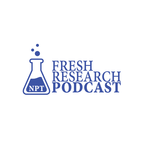
Fresh Research, a NonProfit Times Podcast
Summary: A Podcast by The NonProfit Times: The Leading Business Publication For Nonprofit Management
- Visit Website
- RSS
- Artist: The NonProfit Times
- Copyright: © 2018 The NonProfit Times
Podcasts:
The M+R Benchmarks Report has become one of the most anticipated studies of the year. For more than a decade, it has tracked trends and data for nonprofits, ranging from email open and response rates to social media and mobile fundraising. This year’s study collected data from 154 nonprofits about all things digital, from email and social media to websites and digital advertising. The report’s findings are derived from almost 4.7 billion email messages, more than 527 million web visits and close to 12 million donations. For every 1,000 email addresses, nonprofits had an average of 474 Facebook fans, 185 Twitter followers, and 41 Instagram followers. Will Valverde, vice president at M+R and one of the study’s authors, joins us on this episode to talk about some of the numbers they found this year, including the continuing trend toward mobile and just how many of your supporters actually see that Facebook post from your nonprofit. For instance, on average, each post a nonprofit made on Facebook only reached 7 percent of its fans last year and any given post reached an average of 112 people for every 1,000 followers. There’s only so much of the 118-page report we could squeeze into this episode but you can find the complete report at www.mrbenchmarks.com *** Jack Wertheimer has been studying Jewish philanthropy for more than a quarter of a century. A professor of American Jewish History at the Jewish Theological Seminary of American in Manhattan, Wertheimer updates a study he did some 25 years. With support of the Avi Chai Foundation, he recently released “Giving Jewish: How Big Funders Have Transformed American Jewish Philanthropy.” Among his findings, Wertheimer said Jewish organizations — not unlike many other nonprofits today — are relying more and more on fewer and fewer donors. A complete copy of the 60-page report can be found here here. For more episodes of Fresh Research, click here.
Your browser does not support the audio element. Conventional wisdom has always suggested that a nonprofit make a clean break from its founder, to avoid the dreaded “Founder’s Syndrome.” But according to research by Jari Tuomala and Donald Yeh of The Bridgespan Group, organizations can benefit when they carefully plan an extended role for founders who step down. They recently published “Making Founder Successions Work” in Stanford Social Innovation Review (SSIR), based on more than 500 leadership transitions at nonprofits. Only about one in four transitions involve an involuntary break but almost half yield some type of new role for the founder, ranging from a paid or unpaid advisory/consulting role to a board member or full-time or part-time staff. Their research identified four types of founder transitions and seven signs that a founder has stayed too long. The study is based on Form 990 from 2,000 organizations in addition to 538 responses to a survey disseminated by BoardSource, GuideStar and Bridgespan, as well as interviews with almost 50 board members, founders and successors. Of the survey responses, 474 experienced one or more transitions and another 50 experienced two transitions for a total of 524 transitions. *** The largest generation since the Baby Boomers has finally come of age, with the oldest now approaching 40 and the youngest in their mid-20s. Derrick Feldmann has been studying millennials for almost a decade. He’s founder of The Millennial Impact Project, which puts out an annual study of millennial cause engagement that examines “the subject through a new lens each year since 2008.” The latest research is the 2017 Millennial Impact Report: “An Invigorated Generation for Causes and Social Issues.” It looks at the differences in how millennials have engaged before and after the 2016 presidential election. “Millennials who have been most passionate about causes and social issues have considerably increased their activity.” We talk about what that means for nonprofits and what organizations can do with that information. For more episodes of Fresh Research, click here.
Your browser does not support the audio element. Digital leaders on senior nonprofit management teams can make a huge difference. So why doesn’t every organization do it? That’s part of the discussion with Jason Mogus, principal strategist at NetChange Consulting, and Austen Levihn-Coon, digital organizing director of Planned Parenthood Federation of America. They surveyed 80 advocacy organizations about their digital teams and programs. Some of the results may surprise you and there are a few new trends since the 2014 results. Their report, “Digital Teams in 2018: The new landscape of digital engagement,” can be found here. Ten thousand Baby Boomers a day are turning 65. What’s that mean for the leadership of the nonprofit sector? Peggy Morrison Outon and Carrie Tancraitor of the Bayer Center for Nonprofit Management at Robert Morris University discuss the implications for the Pittsburgh region and beyond and what the nonprofits can do to brace for the future. Their study, “What Now? How will the impending retirement of nonprofit leaders change the sector?”, can be found here. For more episodes of Fresh Research, click here.
Your browser does not support the audio element. Ron Sellers of Grey Matter Research talks about donor perceptions of nonprofits based on their size, from findings in Part V of “The Donor Mindset Study: How Donors See Large Versus Small Organizations.” The study can be found here. Elizabeth Dale, assistant professor of nonprofit management at Seattle University, discusses the characteristics of of high-net-worth female donors. She is the lead researcher on “Giving By and For Women: Understanding High-Net-Worth Donors’ Support of Women and Girls.” The study was done in partnership with the Women’s Philanthropy Institute at the Indiana University Lilly Family School of Philanthropy and can be found here. For more episodes of Fresh Research, click here.